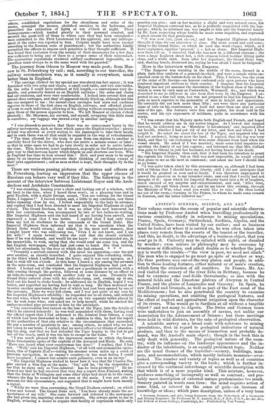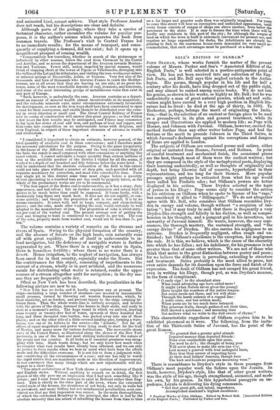ANSTED'S SCENERY, SCIENCE, AND ART. • This volume contains the cream
of popular and scientific observa- tions made by Professor Ansted when travelling professionally in various countries, chiefly in reference to mining speculations. France, Spain, Germany, Switzerland, Sardinia, Algeria, and the United States, have been visited by our author; and as business must be looked at where it is carried on, he was often taken into places very remote from the resorts of the tourist or the traveller. And this, no doubt, is the advantage of a business object, that you must go to it. Curiosity may be satiated with sights, or daunted. by weather; even science or philosophy may be overcome by weariness or difficulties, and admit doubts as to whether the jour- ney is worth the trouble—" the view is poor, we need not climb." The man who is engaged to go must go spite of weather or way. He thus perforce sees out-of-the-way places and people, in addi- tion to those leading features, either natural or of man's creation, which form the attraction of all ramblers. In France, Mr. An- sted visited the scenery of the river Erbe in Brittany, because he had to examine some coal-fields thereabouts ; so also with the mineral fields and the limestone plateau of Aveyron in Central France, and the plains of Languedoc and Gascony. In Spain, he saw Madrid and Granada, as well as part of the East coast of the Mediterranean ; but he also penetrated the country to examine its mining operations, not omitting the geological features, and the effect of neglect and agricultural irrigation upon the character of its rivers. Who would go to Sardinia at all without a tangible object ? and not many to Algeria. The Swiss and German tours were undertaken to join an assembly of savans, not unlike our Association for the Advancement of Science ; but these meetings were held in wild districts, for the sake of geological observation.
A. scientific survey on a broad scale with reference to mining speculations, first in regard to geological indications of natural produce, and then to the means of locomotion and probable de- mand, was Mr. Ansted's main object; though in the book this is only dealt with generally. The geological nature of the coun- try, with its influence on the landscape appearances and the in- dustry of the inhabitants, is an equally prominent topic. Neither are the usual themes of the traveller—scenery, buildings, man- ners, and accommodations, which mostly indicate manners—over- looked. The number and variety of topics as well as of countries give a corresponding variety to the book ; which is further in- creased by the continual interchange of scientific description with that which is of a more popular kind. This mixture, however, produces something of incongruity as well as contrast ; and pro- bably mere description of external nature predominates too much. Scenery painted in words soon tires : the mind requires action of some kind, or interest in the sense of gain—an increase of knowledge or ideas; which pure description, unless of a very terse • Scenery, Science, and Art; being Extracts from the Note-book of a Geologist and Mining Engineer. By Professor D. T. Amsted, M.A., F.B.S., F.G.S., late Fellow of Jesus College, Cambridge, thc. Published by Van Voorat.
and animated kind, cannot achieve. That style Professor Ansted does not reach, but his descriptions are clear and definite. Although parts of the geology, where they take a species of technical character, rather encumber the volume for popular pur- poses, it is the author's science which separates the book from common travels. The Professor's visit to Central France led to no immediate results; for the means of transport, and conse- quently of supplying a demand, did not exist; but it opens up a magnificent prospect of coming wealth.
"Comparatively few travellers, whether in search of the picturesque or influenced by other reasons, follow the road from Clermont by the Centel and Aurillac, and so across the department of the Aveyron towards Montau- ban and Toulouse. Fewer still, unless impelled by special reasons, would think of stopping short at the towns of Figeac or Villefranche, diverging into the vallies of the Lot and its tributaries, and visiting the iron-works,coal-mines, or mineral springs of Decazeville, Aubin, or Cranzac. Very few also of the thousands and tens of thousands who traverse France to reach the Mediter- ranean, are at all aware that they are leaving on one side, at no great dis- tance, some of the most remarkable deposits of coal, ironstone, and limestone, and sonic of the most interesting groups of metalliferous veins that exist in any part of Europe.
"Such, however, is undoubtedly the case. Aveyron contains as a depart- ment an amount of mineral wealth almost inconceivable in its magnitude ; and the valuable minerals exist wider circumstances extremely favourable for development, so soon as the iron ways shall have been constructed to open a road for their conveyance, and enable them to be distributed over the coun- try in every direction at small cost. The Great Central Railway of France now in course of construction will answer this great purpose ; so that within a few years the first results may be anticipated, and France may commence to lay open her stores of coal and iron, and perhaps of lead and copper, and thus come into competition on no unfavourable terms with Belgium, and even England, in respect of these important elements of advance in wealth and civilization.
"I considered it important to obtain an estimate, however general, of the total quantity of available coal in these concessions ; and I therefore made the necessary calculations for the purpose. Owing to the great irregularity in thickness of the different coal-seams, and the very considerable slope of the beds, the result is small compared with other concessions of anything like equal extent. I cannot anticipate a larger quantity than sixteen millions of tons as the available produce of the district I visited for all the seams, if worked to a depth of one hundred and fifty fathoms below the water level. It will be understood that the absolute exhaustion of the field to this extent could not take place without a number of deep pits, each provided with all requisite machinery for extraction, and must take considerable time. From any single pit in this district some time must elapse before a quantity of coal amounting to a hundred tons per day could be properly taken, as the whole of the preliminary works are yet to be commenced.
" The first aspect of the Rodez coal is unfavourable, as it has a stony, dirty appearance, and bad colour ; but on further examination and actual trial it proves to be much better than could be supposed. It burns freely, with a moderately long flame and much heat. It does not die out rapidly, or con- sume quickly; and though the proportion of ash is not small, it is by no means excessive. It cokes well, and in large, compact, and clean-looking pieces ; and the coke, made after washing the coal, would certainly be well adapted to the manufacture of iron. The proportion of coke is about sixty- six per cent of the washed coal. The present average coat of getting the coal and bringing to bank is considered to be nearly 3s. per ton. The cost of the coke, properly made from washed coal, would not be less than 7s. per ton."
The volume contains a variety of remarks on the streams and rivers of Spain. Owing to the physical formation of the country, and the absence of forests on the high lands, rain naturally runs off with great rapidity. This of itself is unfavourable to in- land navigation, but the deficiency of navigable waters is further aggravated by art. Where there is a supply of water in Spain, there is boundless fertility ; where there is no water there is a desert. Hence irrigation, to the neglect of navigation, has always been cared for in that country, especially under the Moors. But the contrivances for this object, consisting of impediments to the current of a stream, wholly or in part artificial, and the numerous canals for distributing what water is retained, render the upper courses of a stream altogether unfit for navigation; in the dry sea- son they are frequently quite dry. Often as New York has been described, the peculiarities in the following picture are new to us.
"New York has no docks, and it hardly requires any at present. The ships—including a large number of steamers—are moored in innumerable small recesses, formed by throwing out wooden frameworks, which, by their elasticity, act as fenders, and prevent injury to the ships entering be- tween them. Thus the whole water-line is entirely occupied, and bristles with the prows of the ships, fastened like horses in their stalls, and ready to start at a moment's notice. The huge vessel in which we arrived, drawing some twenty or twenty-five feet of water, upwards of three hundred feet long, and three thousand tons burden, was packed away into one of these places ; and on the other side of a little covered landing-pier, forming a ware- house, was one of its fellows in the service—the ' Atlantic.' Not far off, others of equal magnitude and power were lying ready to start for the Gulf of Mexico, and many more for various destinations. The mercantile steam navy of the United States, as illustrated along the shores of the New York peninsula, is one of the best and most striking indications of the nature of the people and the country. It all looks as if essential greatness was strug- gling with time. Much wants doing ; but we only know how much when we consider what vast results have already been obtained, and we can only do justice to these results when we bear in mind what have been the efforts made and the difficulties overcome. It is not fair to form a judgment with- out eonsidering all the circumstances of a case ; and one has only to watch the rapid strides that are manifestly made in the direction of improvement, to feel convinced that many things which are now objectionable will dis- appear in a short time.
"The street architecture of New York shows a curious mixture of Dutch and English styles. Without anything to remark on in detail, the first glance of the city gave me an impression that I had seen something like it before ; and I soon found the antetype to exist in Holland rather than Eng- land. This is chiefly in the older part of the town, where the extremely varied style of the houses, the abundance of red brick, not only in walls but as pavement, and many trifling but not uninfluential peculiarities, soon con- vinced me that my first impression was correct. In the main thoroughfares, of which the celebrated Broadway is the principal, the effect is lost by the absolute necessity that has arisen of rebuilding the houses from time to time on a far larger and grander scale than was originally imagined. For years to come this street will bear an incomplete and unfinished appearance, until every house consists of ranges of shops one above another, from below the pavement to the attics. It is easy to foresee the time when there will be hardly any residents in this part of the city; for although the tongue of land on which the town is built is extremely convenient for present use, and requires no large expenditure for docks, the inhabitants are already be_ ginning to find, in the enormous house-rents demanded for very small ac- commodation, that such advantages must be purchased at a dear rate."



































 Previous page
Previous page